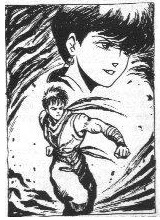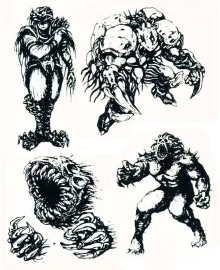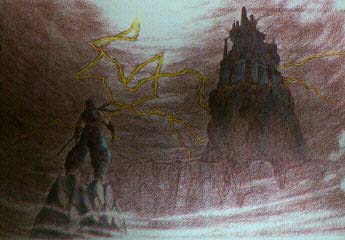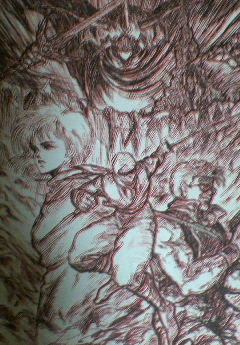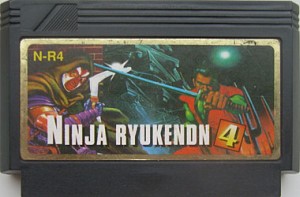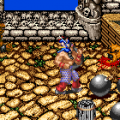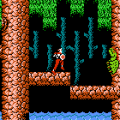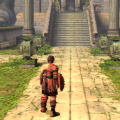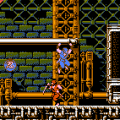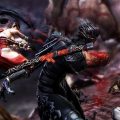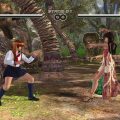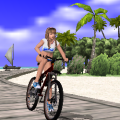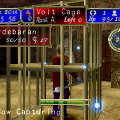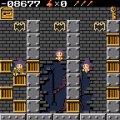- Ninja Gaiden (Arcade)
- Ninja Gaiden (NES)
- Ninja Gaiden II (NES)
- Ninja Gaiden III (NES)
- Ninja Gaiden Shadow
- Ninja Gaiden (Game Gear)
- Ninja Gaiden (Master System)
- Ninja Gaiden (Genesis)
- Ninja Gaiden (2004)
- Ninja Gaiden: Dragon Sword
- Ninja Gaiden II (2008)
- Ninja Gaiden 3 (2012)
- Yaiba: Ninja Gaiden Z
- Ninja Gaiden Old & New
- Ninja Gaiden: Miscellanous
- Masato Kato (Interview)
Thank you for lending us your time. Please introduce yourself shortly.
Hello, my name is Kato.
Since these are all stories from 20 years ago, I’m not sure if I’ll remember everything, but I’ll answer as good as I can.
At the time when Ninja Ryūkenden was made, developers usually used pseudonyms for the credits in games. You were called “RUNMAL”. What does that mean?
‘RUN’ comes from the English verb ‘to run’. ‘MAL’… how can I explain it? It was common with old male names in Japan to have ‘maru’ at the end. Ushiwakamaru would be an example. When written in Romaji, it would usually become ‘maru’, but I wanted to give it a little twist. (It reads “RUNMARU” in the first game, and “RUNMAL” in the other two – ed.)
What kind of work did you do at Tecmo?
At the first game, I only did the graphics. For the second one graphics and scenario. During the development of number three, I was the director for the action part.
For the overseas market, the game was renamed Ninja Gaiden. That is also Japanese, but “Gaiden” is usually used for spin-offs to a game series. Do you know why the name has been chosen?
Just because it sounded cool. *laughs
Regardless whether it was an original story or a side story, anything was good as long as it sounded cool, I guess. Our planning staff were racking their brains over how to carry over “Ryuukenden” into English, and came up with a lot of thoughts, but ultimately, they couldn’t find a translation that quite hit the mark.
You are credited for very different tasks in each game. Let’s talk a bit about each one. In the first Ninja Ryūkenden, it says you did art. Was that limited to in-game graphics, or did you also do stuff like the manual, the cover, and the like?
Basically, I was responsible for the backgrounds, the hero and enemies for the action part. Beyond that, I did also images for the Cinema Display. Those were all pixel graphics. Furthermore, I drew the images for the enemy introductions in the manual. Since my drawings hold some peculiarities, I think people who know (my style) might recognize it there.
Ninja Ryūkenden II‘s credits list you for enemy design. Did you also do the bosses? Are there any designs you were proud of in particular?
I designed the enemy characters for all three games, and drew their pixel art. Enemies I particularly liked are The Jaquio, Ashtar and Kelbeross. I also liked the arch demon from the 2nd game.
Besides the Famicom game, there is also an Arcade version of Ninja Ryūkenden, but the two games are very different. They seem completely unrelated, but has there been any cooperation between the two teams? Which game came first? Were there any requirements for similarities between them?
Both were developed side by side on the same floor, at the same time. However, we only shared the same title, while each team developed their game as they pleased.
The director of the arcade game is called “Strong Shima” in the credits. His name could be seen in a lot of Tecmo’s arcade games at the time. Do you know what he does nowadays?
After he left Tecmo, he entered a company that produces model figurines. I think they’re doing miniatures for TV commercials and big display models to decorate the booths at various shows.
Do you keep any souvenirs from that time, sketches or the like? If yes, could you show us some examples?
I’m sending you an image of Ryu gazing at the enemy’s hideout from NR1, and another illustration, for NR2. I drew those two at the time of the development.
Ninja Ryūkenden I is (in)famous for its extreme difficulty. Especially after losing against the last boss, and having to start at the beginning of the whole chapter, a lot of gamers were faced with despair. At that time, was it your conscious aim to create such a hard game?
Mr. Yoshizawa directed the action part for the first game, but that was actually something a programmer had implemented this way accidentally. However, no one tried to fix it. They were like “hey, that’s not bad, either”. *laughs*
The “Body Split” technique in Ninja Ryūkenden II was very popular (at least in the West). Why was that dropped in the third game?
Because it was too powerful. *laughs* When we developed the sequel, there were concerns of drifting too much towards “power gaming”. There was talk that it would have been cool to have more than 2 of them, but even 2 had been difficult to do with the Famicom’s hardware specifications. So we dropped the Body Split, and looked for different interesting features.
Quite a while ago, an unused music tune found in the ROM to Ninja Ryūkenden II had surfaced on the internet. Do you remember what it was intended for? Were there other things in the games that had to be cut?
I can’t remember that tune at all. But hearing it now, it doesn’t seem like a very good tune, so it probably was discarded because of that. *laughs*
There had been quite a few music tunes that got cut. I think the sound team had to deal with a lot of dismay. *laughs*
With Ninja Ryūkenden, I don’t think there was anything we didn’t include because of the schedule. There were a lot of things we couldn’t do because of the limitations of the FC, or because of our own inexperience, though.
Ninja Ryūkenden III differs a lot from the other two, concerning both action and story. You’re credited for both in the game. Was it your conscious intention to shake up the formula?
First, Mr. Akama was in charge of the story, not me. I only helped a bit to give it a direction. I’ve briefly mentioned it when talking about the “Body Split” art, but while 2 was the natural evolution of 1, with the third game we felt that there was no choice but to go into a new direction. It was the same with the mechanical enemies. The first two games showed a world view similar to the Cthulhu mythos, so we wanted to change that this time around with a science fiction feeling to the world.
When Ninja Ryūkenden III came out in Japan, it was quite a bit easier than its predecessors. Did you know why the game was made harder for the US release? The password system was abolished, and most of the enemies turned out much stronger.
NR1 and 2 had been extraordinarily hard, and had a general reputation as “Ultra-Maniac” games. With 3, we wanted to change that as much as possible, to create a game a normal player can enjoy. But I guess hard games were popular with American gamers, so the company demanded “make it harder!” That’s why the NES version got changed.
Which one was your favorite of the three games?
I like NR2 the most. I think it delivers the best composition of action, story, music and overall balance in the series.
Have there been any games by other companies that influenced your work on Ninja Ryūkenden?
I don’t know if it had any influence whatsoever on the game, but at that time I liked Rockman (Mega Man in the west – ed.), and played it a lot.
Now I’d like to ask a few questions about the story. Ninja Ryūkenden was most famous for its “Cinema Display” cut scenes. At the time, story in action games usually ended with the manual. There might have been a few home computer games with cut scenes, but there hadn’t been anything like that on a home console up to that time. What was the motivation to go through the pains of creating an action game with such storytelling techniques?
It was the idea of Mr. Yoshizawa, who has to be called the father of the series, to create an action game with a dense story. He also wrote the story to the first game. When drawing the images to that story, I was constantly complaining about it, so he finally said: “If you’re gonna moan all the time, just write it yourself!” So I came to write the dialogue in the sequel. One might say that creating of course means to make something that hasn’t been there until then, anyway, but yeah, even at the time of development, I felt we were creating something that hasn’t been done before.
The Japanese Wikipedia says that the story of NR3 takes place in between the other two, since Ryu lost the Dragon Sword at the end of the second game. However, in the English manual, the events of both previous games are presented as being in the past. As I couldn’t get hold of the Japanese manual, could you clarify this?
What? Does it really say that in the English manual? That’s strange.
The events of 3 take place in between 1 and 2. NR2 had ended so well, so when we planned the follow-up, we had to ask ourselves, “how can we continue that?” So we decided to conclude the story around Foster, set at a time before the second game.
In 1991, an OVA based on the series was released. Did the game developers have anything to do with that?
At the very beginning, a meeting was held about the general concept for the anime. After that, they went on to produce it independently.
In NR2, it looks like Robert is dying, but in the OVA, he is alive and well. Is that considered canon?
We drew the scene so that it would look like he’d die, but actually, he was supposed to have survived. Hey, he is a pretty popular character. After all, Ryu didn’t have too many companions, so we wouldn’t dare to let him die so easily. *laughs*
After NR3, Tecmo didn’t develop any more games in the series for a while, but there have been several other games by Sega and Natsume. Do you know anything about the production of those games?
Those outsourced games were completely developed at the outside companies, so I didn’t have anything to do with them.
After NR3, both you and Mr. Yoshizawa left Tecmo. Did that have anything to do with the Ninja Ryūkenden series?
Mr. Yoshizawa actually left Tecmo a few years later than me. Nowadays he’s very busy working with Namco.
Have you played any of Tecmo’s new Ninja Gaiden games on Xbox or PS3? What did you think of them? Did you feel they strayed too far from the source material?
I think the Ninja Gaiden series is doing well. I like them a lot. But they’re so hard, I can’t beat them. *laughs*
Since Ryuukenden is an already 20 years old Famicom game, it goes without saying that Ninja Gaiden is different. And I think that’s for the better.
Nowadays, you’re mostly known for your work on famous RPGs, like the Chrono or Seiken Densetsu series. Would you like to some day go back to develop an action game like Ninja Ryūkenden? Among the classic gaming community, there’s a lot of people who’d like to see another 2D game in the series. Just hypothetically, if someone would develop a “Ninja Ryūkenden 4” for wiiWare, similar to Capcom’s Mega Man 9, would you be on board?
There may be a saying that a cobbler should stick to his last, but I think that even if I’d do an action game again, I’d rather try something new. Concerning a possible Ninja Ryūkenden 4, it would be impossible for me, even hypothetically, to continue a 20 years old product. *laughs* I’m a very different person than I was 20 years ago, after all. (This was years before Kato would return to the series to pen the story for Ninja Gaiden 3 – ed.)
Your latest work is World Destruction (Sands of Destruction in the US – ed.). You’re also involved with new add-on scenarios for Final Fantasy XI. Do you already have any plans after that?
Yeah, I created the original scenario for World Destruction. There are a few other projects after the Add-ons to FFXI are done, but it’s too early to talk about them, yet.
Is there anything left you’d like to say to our readers?
Ninja Ryūkenden was my first full project, with which I entered the gaming world. It has been a long time since that title, I think it is amazing that it hasn’t been completely forgotten by the fans by now. 20 years ago, Ryu, Irene and Robert were an important part of my life. If Ryu and Co. still live on among you fans, then there’s nothing that could make me happier.
THANKS!
